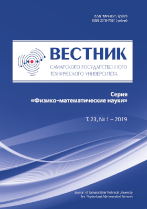|
This article is cited in 6 scientific papers (total in 6 papers)
Mechanics of Solids
The limit diagram under hot sheet metal forming.
A review of constitutive models of material, viscous failure criteria and standard tests
I. E. Kellerab, D. S. Petukhovba, A. Kazantseva, V. N. Trofimova
a Perm State National Research Polytechnical University, Perm, 614990, Russian Federation
b Institute of Continuous Media Mechanics UB RAS, Perm, 614013, Russian Federation
(published under the terms of the Creative Commons Attribution 4.0 International License)
Abstract:
Methods of theoretical analysis and experimental verification of conditions of limit deformation are considered for a reasonable choice of the constitutive equations for mathematical modeling of processes of hot and warm treatment by pressure of sheet metal products with a deep drawing.
Attention is focused on the forming limit curve of sheet metal on the plane of the principal strains (one of that corresponds to stretching, and the second can specify stretching or compression), the characteristic of the local state of the material corresponding to the critical growth of strain localization.
Localization here is understood as a local thinning of the sheet and corresponds to diffuse form of localization. Other defects (shear bands, crack formation) develop from this limiting state or (formation of folds and wrinkles) are not local and require complete formulation of the problem.
The forming limit curve (FLC) defines the conditions of realization of a technological process and can be theoretically predicted depending on the constitutive equations of plasticity, indicator of critical state and initial imperfections.
The Marciniak–Kuczyński scheme is considered for getting FLC, where the sample has two zones of homogeneous strains and allows analytical reduction of the problem to the system of several ordinary differential equations solved numerically.
The experimental methods assume testing by pressing a punch with a spherical or cylindrical tip into a specimen cut from a sheet. Depending on the depth of the lateral cutouts from the specimen, it can be provided tension or compression of the specimen in the transverse direction in these tests.
Both approaches are analyzed as tools for selection and experimental verification of the constitutive model and the limit state indicator. They solve methodological problem of identification of mathematical models on a quite non-standard experiments involving strain localization.
With the use of Marciniak–Kuczyński scheme the effect of a number of yield criteria for anisotropic sheet metal, hardening laws, damage accumulation models and criteria of viscous failure on qualitative and quantitative features of the FLC. To do this a proprietary algorithm has been developed.
Experimental standard test methods of Hasek, Marciniak and Nakajima were implemented numerically in the software package LS-DYNA. The numerical FLD obtained were compared with theoretical and experimental ones.
Possibilities of integration into Marciniak–Kuczyński scheme the dependence on temperature, strain rate and microstructure parameters for each basic rigid-plastic (scleronomous) model were discussed.
It is noted this scheme is significantly limited by proportional changes of the main deformations in the sample outside and inside the strain localization zone.
It is revealed this scheme is not adapted for determination of limit properties of the metals deformable in the conditions of deformation softening (aluminum, titanium alloys and some steels at temperatures of dynamic recrystallization).
For a wider range of material deformation conditions, there is no alternative to the above-mentioned numerical method for predicting FLC.
An open and relevant question is the description of the evolution of anisotropic plastic and fracture properties due to the anisotropic damage accumulation.
Keywords:
sheet metal forming, forming limit diagram, viscous failure criteria, plastically anisotropic materials, material models, calculation, standard experiment.
Received: February 17, 2018
Revised: July 11, 2018
Accepted: September 3, 2018
First online: October 6, 2018
Citation:
I. E. Keller, D. S. Petukhov, A. Kazantsev, V. N. Trofimov, “The limit diagram under hot sheet metal forming.
A review of constitutive models of material, viscous failure criteria and standard tests”, Vestn. Samar. Gos. Tekhn. Univ., Ser. Fiz.-Mat. Nauki [J. Samara State Tech. Univ., Ser. Phys. Math. Sci.], 22:3 (2018), 447–486
Linking options:
https://www.mathnet.ru/eng/vsgtu1608 https://www.mathnet.ru/eng/vsgtu/v222/i3/p447
|

| Statistics & downloads: |
| Abstract page: | 697 | | Full-text PDF : | 388 | | References: | 64 |
|



 Contact us:
Contact us: Terms of Use
Terms of Use
 Registration to the website
Registration to the website Logotypes
Logotypes